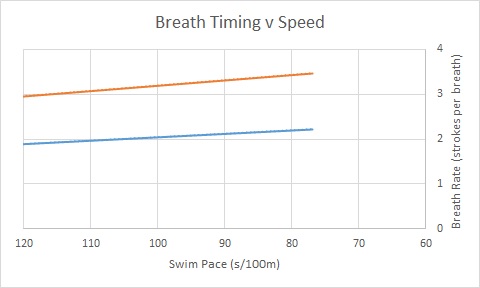How often should I breathe when swimming?…
Alan Couzens, MS (Sports Science)
Sept 12th, 2014

As often as you need to!
... end of blog :-)
Well, that short, simple answer is 100% spot on but I know you want more info that that. So here goes….
I saw this great article on Swimsmooth.com on the subject of breath frequency while swimming & figured I would add some quick observations on the topic.
If you ask around the elite triathlete ranks, you might be surprised by the intensity of views on this subject. Some will swear by the stroke balance that breathing every 3rd stroke provides while others (typically ex pool swimmers) will sing the praises of the extra O2 that breathing every stroke offers. So who is right?
There is good reason for the intensity of positions on the subject – this O2 thing is pretty important! In short, it’s so important that other stroke considerations will be built around ensuring its adequate supply. So how much do we need?
Not surprisingly, (at least over longer distances) the answer depends on how fast you’re swimming. If you want to putter along at 2min/100, most of us can get by with pretty minimal amounts of O2 uptake – in the range of 1.5L min. However, at faster paces, this quickly escalates & at paces typical of competition levels of output (1:15-1:30/100m), it can approach 4L/min!
This is a lot of O2 & it’s going to take a good number of breaths per minute to get that amount of O2 to the muscles – somewhere in the range of 30-40 breaths per minute. To a large extent, this is non negotiable, i.e. if the swimmer wants to swim at this level of output, he’s going to need to find a way to fit 30-40 breaths into each minute of swimming. The element that IS more negotiable is the number of strokes that the athlete takes within that minute to swim at those paces. Those with more of a ‘swinger’ tendency may be taking close to 80spm to hit those paces, while the prototypical ‘smooth’ ex pool swimmers may get the job done in as few as 50spm!
Therefore, the number of breaths per stroke is very dependent on 2 things…
- How fast you’re swimming
- Your 'swim type’ (i.e. your natural stroke rhythm)
The relationship between these things and breath timing is shown on the chart below for 'Smooths' (in blue) and 'Swingers' (in red).

For intermediate to advanced level swimmers, swimming at a pace of 2min(120s) per 100m is going to require a (paltry) VO2 uptake of 1.5L/min and a respiration rate of <20 breaths per minute (only marginally above resting rates) to provide that level of O2 to the working muscles. As the pace increases to 75-90s per 100m, O2 demand will approach 4L/min, requiring a respiration rate of ~30-40 breaths per minute (based on the average data from VO2max tests that I've performed).
As stated above, stroke rates for these high end paces may vary from 50-80spm depending on the type of swimmer we’re working with. If we divide these 2 numbers you’ll see that at most paces, ‘swingers’ - those rating at or close to 80spm at those paces (represented by the red line on the chart) won't need to breathe every stroke cycle to get 30-40 breaths per minute, while ‘smooths’ - those rating closer to 50spm (represented by the blue line) will likely need to breathe once every stroke cycle to match the required respiration rates.
This is exemplified when we compare the patterns of current 1500m world record holder Sun Yang, who rates at a slow ~60spm (and breathes at ~30bpm) and faster rating swimmers like former Olympic 400 free champ Brooke Bennett who rates almost twice as fast but breathes at a similar 35 breaths per minute – shown below.
Yang
Bennett
As you can see, while Yang breathes (at least) every stroke cycle (2 strokes per breath), Bennett includes periods of no breath swimming to bring the overall breaths per 50m down to ~17-18. Very similar to the 14-15 used by Sun Yang. However, because she is rating almost twice as quickly (close to 100spm!), she has to include strokes where she doesn’t take a breath to bring that RR down to ~35 breaths per minute (& presumably blow off the extra CO2 to prevent herself from hyperventilating! :-) This pattern brings her strokes per breath to the average of ~3 given for 'swingers' above.
This is not to discount the benefits of bilateral breathing – both to stroke balance and to the tactical benefits of being able to see your opposition &, in the case of open water swimming, to be able to breathe in some ‘clean’ water, just to say that in selecting your overall pattern, be mindful of your swim type and make sure you’re getting enough of that precious O2!
Swim smart!
AC
Tweet**************************
